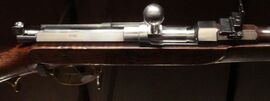The Dreyse Needle gun, named the Zündnadelgewehr (Needle Ignition Rifle) in German, was a breechloading rifle which, unlike the percussion rifles of the time, used a long needle-like firing pin to pierce the paper cartridge and strike the percussion cap within it. It was designed in Prussia by Johann Nikolaus von Dreyse for the Prussian army, based on the prior work of Swiss inventor Jean Samuel Pauly.
Design Details
The Dreyse Needle gun was among the first firearms to feature a firing pin, developing upon the invention of the percussion rifle. It was also the first breechloading rifle to use bolt action to open and close the chamber. The percussion rifle used a hammer to strike an external percussion cap, placed on a nipple above the breech of the rifle, to ignite the powder. The Dreyse Needle gun, on the other hand, used a spring (which was reset by pulling the bolt back to open the chamber) to push a firing pin into the paper cartridge (which contained the bullet, percussion cap and gunpowder) and ignited the charge, firing the bullet.
The Dreyse Needle gun featured a fixed v-notch at the back and post at the front for sights, along with the possibility to fix a bayonet to it. The Dreyse was issued with two spare needles, as the needle would often fail, having to be in the gunpowder when it was ignited. British evaluations found that the needle had to be replaced every 12 shots.

A close-up shot of the bolt-action system on the Dreyse Needle gun
For all its innovations, it had a significant number of flaws, with the same British evaluation concluding the rifle to be too complex and fragile for military use. Both the firing pin and its spring were prone to failure, though the action of replacing the firing pin only took around 30 seconds for a trained user. The combustible ammunition also led to fouling issues, requiring cleaning every 60-80 shots to keep the action working properly: if fouled and hot, it could become extremely difficult to operate the action.
Furthermore the bolt action mechanism for opening the chamber caused a significant amount of gas-leakage which increased with prolonged firing, which not only reduced the effective range and velocity of the bullet, but also had the potential to burn the user.
Ammunition
The Dreyse Needle gun, unlike its main muzzle loading contemporaries, had a paper cartridge which was inserted directly into the gun's action rather than just being a convenient way to carry bullet and powder together. The case was a "combustible cartridge" designed to burn up during firing, a type of ammunition more commonly seen on large cannons and naval guns.
This contained an acorn-shaped bullet of 0.61in caliber (15.4mm) with the percussion cap attached to it in a separate section named the sabot. Behind this was the gunpowder: due to this configuration, the powder would burn front-to-back.

Diagram of the paper cartridge for the Dreyse Needle gun
Usage
The Dreyse Needle gun was first adopted in 1841 by the Prussian army as the "Leichtes Perkussionsgewehr Model 1841" or Light Percussion rifle Model 1841, to disguise the true nature of the weapon. Mass-production proved a significant problem until the development of cast-iron gun barrels, with the Dreyse significantly outnumbered in service by the obsolete Potsdam musket for much of its early life, only seeing large-scale service after the Second Schleswig War of 1864.
The Dreyse's first major conflict was the Austro-Prussian War in 1866. Austrian and German confederate states were equipped with muzzle loading Vereinsgewehr and Lorenz Rifles, which were offshoots of the Minie Rifle, firing the Minie Ball. Though these rifles had an advantage in terms of range and muzzle velocity over the Dreyse, their low rate of fire (average of 2-3 shots per minute) gave the Dreyse the advantage, able to fire 6 shots per minute.

Reverse view of the Dreyse Needle gun
The Dreyse also benefitted from allowing the user to lay on the ground when reloading, meaning less of the soldier was exposed during reloading and operation. This tactical advantage was another key feature of the Dreyse Needle gun and helped to develop a new method of fighting. The Dreyse's success on the field helped Prussia to unify Germany by 1871 and led to the observation by some of "the needle-gun is king".
The Dreyse, however, did become obsolete in the years following the Austro-Prussian War, being out-performed in the Franco-Pussian War (despite a Prussian victory) by the French Chassepot rifle, hence provoking Prussia, and the united Germany, from 1871 to use the Mauser Model 1871 rifle.